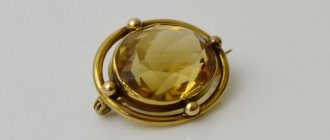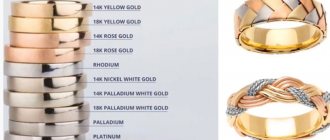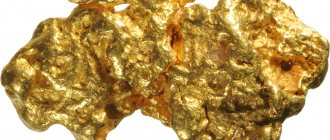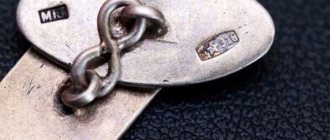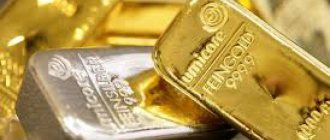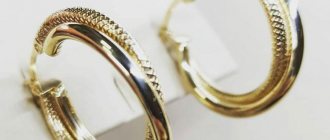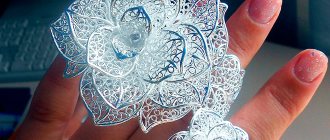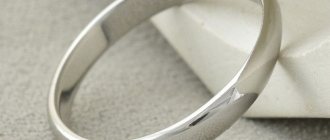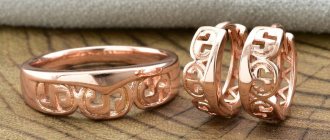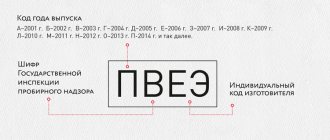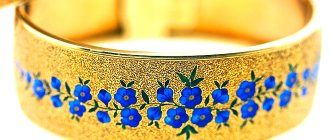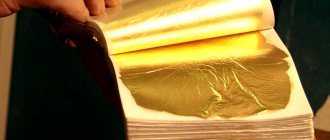The composition of 500 fine gold contains about 50% pure gold, the rest is silver and copper, in various proportions. The 500th grade is a low-grade alloy with low characteristics and has a number of disadvantages:
- The color of products is highly dependent on the percentage of silver contained.
- Low fluidity (hardness, ease of manufacturing and soldering of jewelry).
Among the positive qualities, one can note the rarity of the color range of products made from 500 samples, since the narrow popularity of the alloy makes it unique in the eyes of connoisseurs and jewelers.
Where is 500 alloy used?
In the CIS countries, jewelry with 500 markings is practically not produced due to the complexity of the cast, although the metal has permission for the production of jewelry and some jewelers use this alloy today, for the sake of the unusual shades of the final products.
Hallmark of 500 gold purity in the CIS countries
However, the 500th sample has become widely used as a standard in the examination and inspection of jewelry; it has GOST 30649-99 and the designation: ZlSrM 500-100 .
Abroad, 500-karat gold is used much more often. It is used to make high-class stationery, inexpensive brooches, cufflinks and individual components of precious items.
In Europe, the alloy is often used as gold plating and corresponds to 12 carats according to the foreign hallmark classification system (karat). It is often confused with real gold, be more careful when buying imported jewelry , on them this marking is indicated - 12K FG and is gold plated.
Price for 1 gram of gold 500 standard
Unfortunately, domestic 500-karat gold (12-karat gold is imported) is inexpensive! Considering prices in pawnshops within the former USSR (Russia, Ukraine, Belarus) - for 1 gram you can earn from 10 to 15 dollars .
Foreign jewelry often does not comply with GOST, and after examination of the 585th foreign standard (14 carats), it is lowered to 500 standard (12 carats), due to the low gold content in the alloy.
The decorations themselves are much higher! If you manage to find a direct buyer for the product, the price of the jewelry will double. To do this, you should look for jewelry auctions, or place the product on our website.
Samples and marks on precious metal products
The value of the alloy from which gold, silver, platinum and palladium products are made is determined by a test showing the content of precious metal in 1000 parts (by weight) of the alloy. Assay supervision is carried out by the Assay Supervision Inspectorate of the Precious Metals Department of the Ministry of Finance of Russia.
The value of the alloy from which gold, silver, platinum and palladium products are made is determined by the breakdown , which shows the content of precious metal in 1000 parts (by weight) of the alloy. Assay supervision is carried out by the Assay Supervision Inspectorate of the Precious Metals Department of the Ministry of Finance of Russia.
| Fig.1. Assay marks: main (a-f) and additional (g, h) for hallmarking. |
| a - products in combination with one of the additional marks; b - gold and platinum products; c - silver items; g - palladium products; d - products with seals attached to them; d— books with gold and silver leaf; g— detachable and easily detachable secondary and additional parts of products; h— products that do not correspond to the declared sample, and those whose sample after restoration turned out to be lower than the established one |
In 1927, the following samples of alloys based on precious metals were established in the USSR:
- samples for products made of gold-based alloys - 375, 500, 583, 750, 958;
- samples for products made of silver-based alloys - 750, 800, 875, 916, 925; 960;
- samples for products made of platinum alloys - 950;
- samples for products made of palladium alloys - 500, 850.
Western countries use the carat system , in which 1000 metric hallmarks equal 24 carats. To convert a sample from metric to carat, the following ratio is used:
b = 24x/1000
where b is the fineness in carats; x—metric standard. For example, the 750th hallmark corresponds to 18 carats, the 583rd hallmark - 14 carats, the 375th hallmark - 9 carats.
Branding of products made of precious metals is carried out with main and additional brands (Fig. 1).
The main hallmarks include the hallmarks of the letters “A”, “B”. "B" and "G"
The stamp of the letter “A” has a round shape and consists of an identification mark (the hammer and sickle emblem against the background of a five-pointed star with a three-digit hallmark number) and the hallmark inspection code.
The letter “B” stamp can be of several types:
- a mark in the form of a spatula, consisting of an identification mark, an assay inspection code and a hallmark, intended for marking gold and platinum products;
- a mark in the form of a rectangle with convex opposite sides consisting of an identification mark, an inspection code and a hallmark (750, 800, 875, 916, 925 and 960), used for marking silver products;
- a truncated oval-shaped stamp, consisting of an identification mark, an inspection code and a sample (500, 850). Designed for branding products made from palladium-based alloys.
The stamp of the letter “B” is double-sided, round; consists of two parts: an identification mark with the assay code and a round sign with assay numbers. It is used to brand products made of precious metals on plates attached to them.
The letter “G” stamp has an oblong shape with rounded corners. It consists of an identification mark, an inspection code and a sample and is intended for branding thin-sheet (leaf) gold and silver.
Additional hallmarks include the letters “D” and “E”.
The letter “D” stamp has a square shape with cut corners. This mark is used to mark detachable, secondary and additional parts of products made of precious metals.
The stamp of the letter “E” has a square shape with cut corners and the letters “NP”. Designed for branding products made of precious metals that do not correspond to the declared standard.
Branding of products made of precious metals is carried out based on the results of testing them on a touchstone and control analysis with the following deviations from the established standards:
- for gold-based alloys no more than +/- 3 samples;
- for silver-based alloys no more than +/- 5 samples;
- for platinum-based alloys no more than +/- 5 samples;
- for palladium-based alloys no more than +/- 5 samples.
In practice, they use the simplest method for determining the sample of precious metals and their alloys - applying a solution of gold chloride directly to the test product. Place a drop of gold chloride solution on the clean surface of the metal or alloy being tested and monitor the result.
As a rule, a stain of sediment appears on the wetted surface, by the color of which the metals are determined (Table 1).
Table 1. Determination of metal by applying a solution of gold chloride.
| Color of the metal being examined | Spot color | Spot formation time, s | Detectable metal |
| White | Dark green | 1—2 | Pure silver or high-grade silver-based alloy |
| Yellow with gas evolution, gradually turns black | 1—2 | Aluminum | |
| Black | 30—40 | Tin | |
| Grayish white | The solution has no effect | 30—40 | Platinum |
| Grayish white | Yellow, quickly turns black | 1—2 | Zinc |
| Slate gray | Dirty yellow | 1—2 | Lead |
| Yellow | The solution has no effect | 1—2 | Gold and its high-grade alloys with silver |
| Chestnut | 60—360 | Low-grade (less than 583 samples) alloys of gold with silver and copper | |
| Black | 1-2 | Brass | |
| Whitish yellow | 1—2 | Low grade alloy of silver and copper | |
| Red | The solution has no effect | 1—2 | High-grade alloy (above 583 purity) of gold and copper |
| Golden or chestnut | 60—360 | Low-grade alloy of gold and copper (below 583 standard) | |
| Black | 1—2 | Copper |
The hallmark of a piece of jewelry is the quantitative metal content in the alloy (i.e., how much pure precious metal is contained in 1000 units of the alloy that you hold in your hand). For example, a chain weighing 1 kg and having a purity of 585 contains 585 grams of pure gold! The rest is copper, silver, etc. to taste (415 grams). The mark, which in Russia is placed by the Chamber of Assay Supervision (and not by the master himself, as some people think), confirms that you are holding in your hand a product of exactly 585 samples, which contains exactly 585 parts of pure (999 samples) gold. The craftsman (or company) puts his name on the product, which displays symbols of little significance to the buyer. (On new, recently manufactured products, the first letter of the name is important - it means the year of manufacture: A - 2001, B - 2002 ... F - absent, Z – 2007, the second letter “M” is Moscow, then the letters are the code of the master or company).
Very important to know! When purchasing jewelry, be sure to make sure that there are two hallmarks - the name and hallmark. They must be clearly printed and the name plate must be located only to the left or above the sample. The absence of a name tag in the presence of a sample may mean the following: 1. The sample is fake and the metal is not precious - the worst option that was encountered in the old days. 2. The sample is fake, but the metal corresponds to the declared sample - a very common option, which means that the workshop is working “in the dark”. 3. The sample is real, the product was brought from abroad and also has some kind of foreign stamp (which is clearly readable), then ours (Russian) may not exist. There's nothing wrong with that. Of course, you can run into a product where both the name and hallmark will look like the real thing, and the metal will be fake or covered with a thin layer of precious metal - to avoid this, you need to closely communicate with the seller and take all the necessary sales receipts and certificates from him. It’s also a good idea to look at the name and sample yourself with a strong magnifying glass. Keep in mind that some imported gold-plated products have a mark indicating the sample of this particular gilding (coating), and not what the product itself is made of. Such products are not sampled in Russia. These jewelry can be very expensive and can mislead the buyer about what they are made of. Imported jewelry (not hallmarked in Russia) has so-called “carat” hallmarks (see translation table below). Experience shows that these products are very rarely counterfeit (i.e., made from fake metal), however, the precious metal itself (gold) may be of such a composition that, at the same 585 standard (14 carats), it has a melting point close to melting temperature of the lowest melting point solder. This creates great difficulties during repairs and an inexperienced jeweler can ruin the product. The following can be said about counterfeiting silver products: these products are counterfeited extremely rarely, because the cost of silver is not high, and even if there is a fake hallmark or just numbers like “916” or “925”, without any name, this, in the vast majority of cases, can be trusted. Sometimes items made from base metals are silvered, and the owner thinks that the entire item is silver (this often applies to cupronickel tableware). Nowadays, many silver items made in large quantities are coated with rhodium or sterling silver to prevent tarnishing. This is very good, but if the product is repaired, the coating may come off and the item will not shine as intensely, stains will appear. The coating will have to be restored. Until 1927, a spool test existed in Russia. I have not seen any counterfeits of products with a spool test (although, of course, they exist). The denomination of the sample is easily converted into a modern one using the table. Try not to buy jewelry second-hand, especially from strangers! In this case, I recommend going with the seller to the nearest pawnshop and trying to pledge the product. If accepted, ask the receptionist if the sample is real and what kind of name it is. After this, refuse the deposit under the pretext that “you need to think about it” and decide on the purchase.
All about jewelry samples
Jewelry, as a rule, is not made from pure precious metals. To give them the necessary mechanical properties and color, additives of non-ferrous metals are introduced into them, producing alloys, for example, gold with silver and copper, sometimes with palladium, cadmium, nickel and zinc; silver and platinum - with copper; palladium - with silver and nickel. The content of precious metal in an alloy determines its fineness.
Most countries (including Russia) have adopted a metric system for designating a sample, according to which it is designated by the number of parts of noble metal in a thousand weight units of the alloy.
Until 1927 in Russia there was the so-called. The spool system for designating the sample (based on the Russian pound, containing 96 spools), according to which the sample was expressed by the weight amount of the noble metal in 96 units of the alloy.
In the USA, Great Britain and Switzerland the so-called carat system, according to which the 1000th sample of precious metal corresponds to 24 conventional units.
1 carat hallmark = 4 spool hallmarks = 41,666 metric hallmarks;
1 spool test = 10.4166 metric samples.
The hallmark of precious metal alloys, from which it is permitted to make jewelry and other products, is established by law and guaranteed by the state, for which the products must undergo hallmark control and are stamped with hallmark marks, the numbers of which determine the hallmark. To brand a product in various countries, hallmarks of various shapes and designs are used.
The most common alloy is 583 gold; alloys of this sample can be of different colors depending on the quantitative ratio of non-ferrous metals contained in them. For example, if an alloy of 583 gold (58.3 gold) contains approximately 36 silver and 5.7 copper, the alloy takes on a green tint; at 18.3 silver and 23.4 copper - pink; at 8.3 silver and 33.4 copper - reddish.
For the manufacture of jewelry with diamonds, the so-called. white gold, which contains: in an alloy of 583-carat gold - silver 23.7 - 28.7, palladium 13.0 - 18 or nickel 17, zinc 8.7, copper 16; in an alloy of 750-carat gold - silver 7.0 - 15.0, palladium up to 14, nickel up to 4, zinc up to 2.4, or nickel 7.5 - 16.5, zinc 2.0 - 5.0, copper up to 15.
958 gold alloys are fragile and therefore used in limited quantities!
The 375-carat gold alloy contains: gold 37.5, silver 10.0, copper 48.7, palladium 3.8.
The most common alloy is 875 silver. It is used to make decorations and tableware items. 916 alloy is used for the production of tableware with enamel coating; 960 standard alloy - for the manufacture of filigree products. Alloys of platinum and palladium are used in jewelry in small quantities.
To protect against rapid oxidation and improve decorative properties, silver and brass products are electrolytically coated with a thin layer of 999-carat gold (gilding) or 999-carat silver (silver plating).
